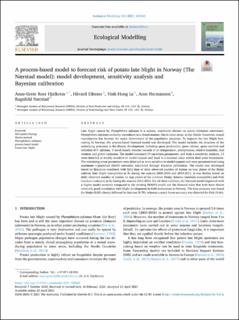| dc.contributor.author | Hjelkrem, Anne-Grete Roer | |
| dc.contributor.author | Le, Vinh Hong | |
| dc.contributor.author | Hermansen, Arne | |
| dc.contributor.author | Nærstad, Ragnhild | |
| dc.date.accessioned | 2021-10-11T18:43:44Z | |
| dc.date.available | 2021-10-11T18:43:44Z | |
| dc.date.created | 2021-07-14T21:21:02Z | |
| dc.date.issued | 2021-04-23 | |
| dc.identifier.citation | Hjelkrem, A.-G. R., Eikemo, H., Le, V. H., Hermansen, A., & Nærstad, R. (2021). A process-based model to forecast risk of potato late blight in Norway (The Nærstad model): model development, sensitivity analysis and Bayesian calibration. Ecological Modelling, 450, 10. | en_US |
| dc.identifier.issn | 0304-3800 | |
| dc.identifier.uri | https://hdl.handle.net/11250/2789101 | |
| dc.description.abstract | Late blight caused by Phytophthora infestans is a serious, worldwide disease on potato (Solanum tuberosum). Phytophthora infestans normally reproduces in a clonal manner, but in some areas, as the Nordic Countries, sexual reproduction has become the major determinant of the population structure. To improve the late blight forecasting in Norway, the process-based Nærstad model was developed. The model includes the structure of the underlying processes in the disease development, including spore production, spore release, spore survival and infection of P. infestans. It needs hourly weather records of air temperature, precipitation, relative humidity, leaf wetness and global radiation. The model contained 19 uncertain parameters, and from a sensitivity analysis, 12 were detected as weakly sensitive to model outputs and fixed to a nominal value within their prior boundaries. The remaining seven parameters were detected as more sensitive to model outputs and were parameterized using maximum a'posteriori (MAP) estimates, calculated through Bayesian calibration. The model was developed based on literature combined with field data of daily observed number of lesions on trap plants of the Bintje cultivar (late blight susceptible) at Ås during the seasons 2006-2008 and 2010-2011. It was further tested on daily observed number of lesions on trap plants of the cultivars Bintje, Saturna (medium susceptible) and Peik (medium resistant) at Ås during the seasons 2012-2015. For all three cultivars, the Nærstad model improved with a higher model accuracy compared to the existing HOSPO-model and the Førsund rules that both have shown relatively good correlation with blight development in field evaluations in Norway. The best accuracy was found for Bintje (0.83) closely followed by Saturna (0.79), whereas a much lower accuracy was detected for Peik (0.66). | en_US |
| dc.language.iso | eng | en_US |
| dc.publisher | Elsevier B.V. | en_US |
| dc.rights | Navngivelse 4.0 Internasjonal | * |
| dc.rights.uri | http://creativecommons.org/licenses/by/4.0/deed.no | * |
| dc.title | A process-based model to forecast risk of potato late blight in Norway (The Nærstad model): model development, sensitivity analysis and Bayesian calibration | en_US |
| dc.type | Peer reviewed | en_US |
| dc.type | Journal article | en_US |
| dc.description.version | publishedVersion | en_US |
| dc.rights.holder | © 2021 The Author(s) | en_US |
| dc.source.volume | 450 | en_US |
| dc.source.journal | Ecological Modelling | en_US |
| dc.identifier.doi | 10.1016/j.ecolmodel.2021.109565 | |
| dc.identifier.cristin | 1921791 | |
| dc.source.articlenumber | 109565 | en_US |
| cristin.ispublished | true | |
| cristin.fulltext | original | |
| cristin.qualitycode | 1 | |

